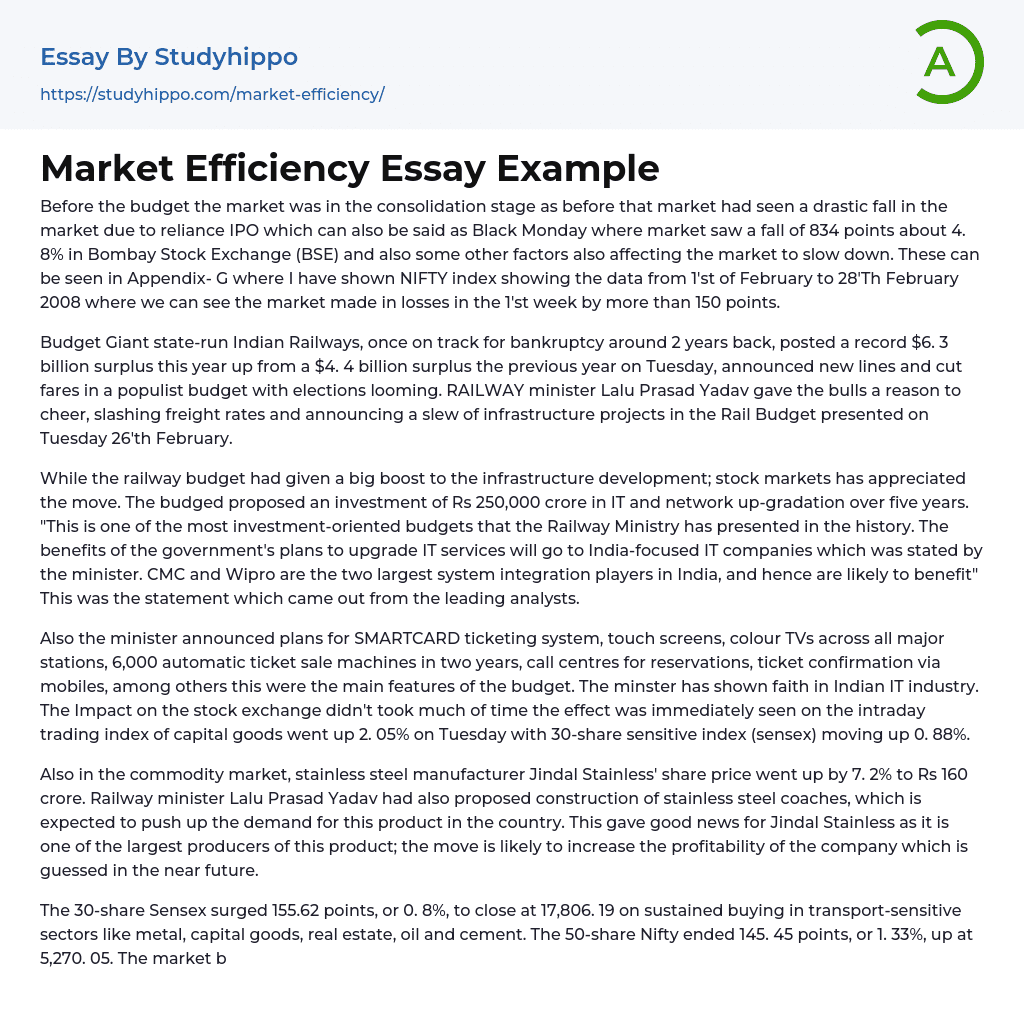Before the budget, the market was in a consolidation stage. Prior to that, there was a significant decline in the market due to the reliance IPO event, also known as Black Monday. This event resulted in a 4.8% fall in Bombay Stock Exchange (BSE) with a decrease of 834 points.
Additional factors contributing to the market slowdown can be found in Appendix-G which displays NIFTY index data from February 1st to February 28th, 2008. In just the first week, there were losses of over 150 points.
However, thanks to the budget turnaround, Indian Railways has achieved a surplus of $6.3 billion. This state-run giant was on the verge of bankruptcy only two years ago and this surplus represents a significant increase from last year's $4 billion.
On Tuesday, 26th February, the Rail Budget for the year was introduced by Railway minister Lalu Prasad Yadav. The budget revealed a surplus of
...4 billion compared to the previous year. With elections approaching, Yadav aimed to please the masses by announcing new railway lines and reduced fares. This announcement brought happiness to the stock markets and also boosted infrastructure development due to lower freight rates and various infrastructure projects. Furthermore, the budget proposed a significant investment of Rs 250,000 crore over five years for IT and network up-gradation. The minister emphasized that India-focused IT companies would greatly benefit from these plans, making it one of the most investment-oriented budgets in Railway Ministry history.
According to leading analysts, CMC and Wipro, the two largest system integration players in India, are expected to benefit. The minister also announced plans for various technological upgrades and improvements in the transportation system, including a SMARTCARD ticketing system
touch screens, and color TVs at major stations. Additionally, there will be 6,000 automatic ticket sale machines installed within two years, call centers for reservations, and ticket confirmation via mobile devices. These initiatives showcase the minister's confidence in the Indian IT industry. The impact on the stock exchange was almost immediate, with the intraday trading index for capital goods increasing by 2%.
On Tuesday, the 30-share sensitive index (Sensex) rose by 0.88%. Simultaneously, Jindal Stainless, a stainless steel manufacturer in the commodity market, saw its share price increase by 7.2% to Rs 160 crore.
Railway minister Lalu Prasad Yadav has proposed the construction of stainless steel coaches, which is expected to boost demand for this product in India. This development will benefit Jindal Stainless, one of the largest producers of stainless steel coaches, and it is predicted that the company's profitability will increase in the near future. Meanwhile, the 30-share Sensex closed at 17,806.19 with a surge of 155.62 points or 0.8%. This rise was driven by sustained buying in transport-sensitive sectors such as metal, capital goods, real estate, oil, and cement. As for the 50-share Nifty closing value, it was not provided.
The BSE index, also known as Sensex, gained 45 points or 1.33% and closed at 5,270.05. The market on the Bombay Stock Exchange showed a positive breadth, with 1,652 shares advancing, 1,074 declining, and 59 remaining unchanged. The combined traded turnover on Tuesday was approximately Rs 5,000 crore higher compared to Monday, totaling Rs 68,000 crore. According to some prominent brokers in the country, the key sectors that would benefit from the budget are logistics, EPC, IT, and electronic equipment.
In conclusion, the market's reaction to
the railway budget 2008 results was highly efficient. The market also takes into consideration factors other than the budget, as shown in Appendix F's graph of leading Indian IT companies Wipro and CMC. Prior to the budget on February 13th, both companies were trading at Rs 409.09 and Rs 438.95 respectively. The strengthening of the dollar against the INR and the news of the budget's proposed investment of Rs 100,000 crore in infrastructure created great business opportunities for Indian companies, boosting the IT stock. After the budget, there was a relatively positive reaction with most cement, steel, power, and IT stocks increasing in value. This resulted in the capital goods index rising by 2.05% on Tuesday, and the 30-share sensitive index (Sensex) also experiencing an increase.
The market responded to the budget by raising the share prices of IT companies, as depicted in appendix F. It also generated optimism for steel, iron, and electronic equipment companies, resulting in a temporary surge in their share prices. However, this increase was short-lived because the investment was intended for the upcoming five years. Furthermore, the market eagerly awaited Union-Budget 2008 scheduled later in the month.
- Futures Contract essays
- Mortgage Loan essays
- Renting essays
- Transaction Cost essays
- Money essays
- Financial Accounting essays
- Market Segmentation essays
- Supply And Demand essays
- Purchasing essays
- Forecasting essays
- Legacy essays
- Bank essays
- Corporate Finance essays
- Financial News essays
- Financial Ratios essays
- Financial Services essays
- Free Market essays
- Shareholder essays
- Personal finance essays
- Equity essays
- Financial Crisis essays
- Banking essays
- Credit Card essays
- Currency essays
- Debt essays
- Gold essays
- Loan essays
- Enron Scandal essays
- Foreign Exchange Market essays
- Investment essays
- Venture Capital essays
- Stock Market essays
- Retirement essays
- Donation essays
- Net Present Value essays
- Income Statement essays
- Commercial Bank essays
- Debit Card essays
- Deposit Account essays
- Subprime Lending essays
- Perfect Competition essays
- Underwriting essays
- Synergy essays
- Valuation essays
- Investing essays
- Asset essays
- Depreciation essays
- Discounted Cash Flow essays
- Foreign Direct Investment essays
- Funds essays




